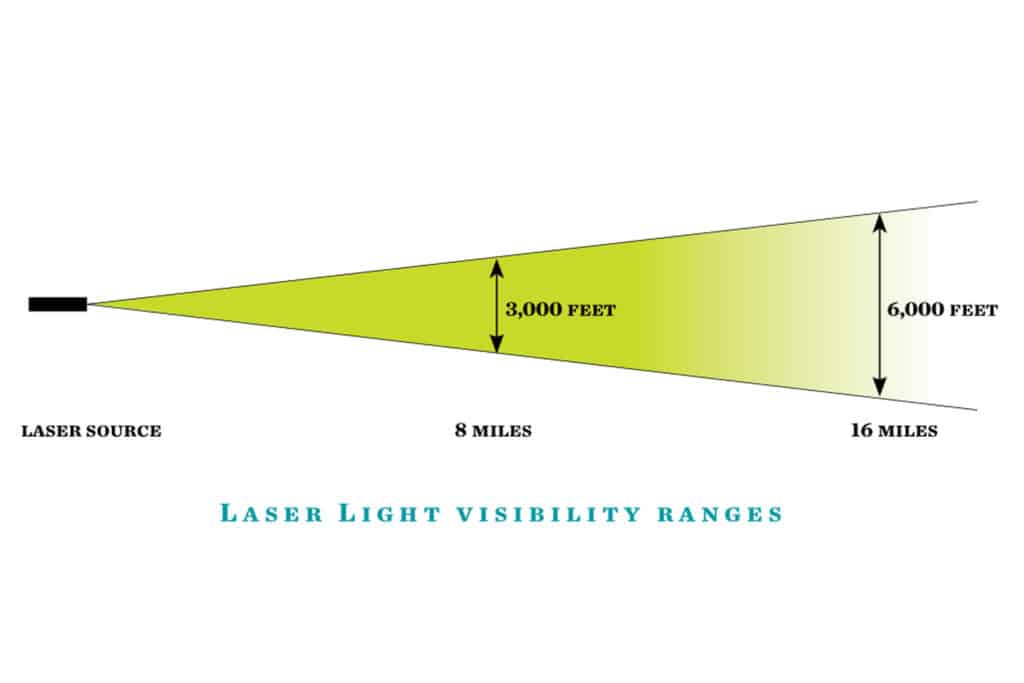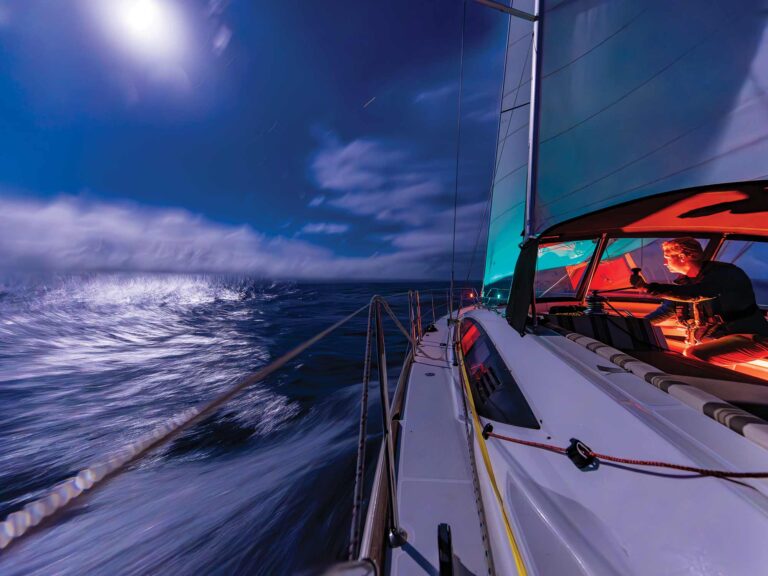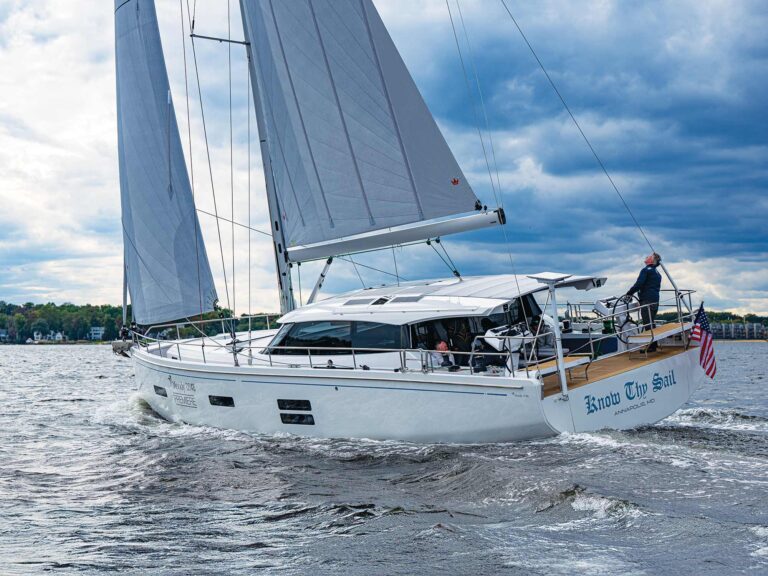For as long as sailors have gone to sea, they’ve relied on the methods of the age for signaling distress and guiding rescuers to their location. Early pyrotechnic boat flares were invented by Martha Coston. Granted a patent by the United States government in 1859, Coston’s signaling devices soon found favor with the U.S. Navy, which originally ordered a set of 300 flares. Since then, thousands of lives have been saved through their use.
Pyrotechnic boat flares have both pros and cons. On the plus side, flares have good visibility, especially at night. Red hand-held flares, meteor flares and parachute flares are all highly visible, depending on range and height of eye. They show up well from an aircraft at night, and reasonably well during daylight.
On the downside, they all have short burn times, varying from five to seven seconds for a meteor flare to a minute for the larger parachute flares, and up to three minutes for red hand-held flares. A standard flare kit as required by law can quickly be exhausted. Their signal can also be degraded by wind and weather.
There are other serious downsides to pyrotechnic flares. Burning flares can reach 3,000 degrees centigrade, and if improperly handled, can cause fire, serious injury, even death. Most flares have a 42-month life from date of manufacture, after which they must be properly stored or disposed of. With nearly 12 million registered recreational boats in the U.S. alone, most of which are required to carry flares, the disposal problems are enormous. Flares are classified by the Department of Transportation as explosives and can’t be carried through airport security. They are considered hazardous material by both federal and state environmental agencies.
With modern technology, alternatives exist, and maritime officials are studying them. Though at present U.S. Coast Guard regulations still require pyrotechnic flares, the day will soon come when they may be obsolete. As many of the regulations governing flare use are international (see “Distress Signal Standards,” below), any overall solutions will affect mariners worldwide.
In the United States, the Lifesaving and Fire Safety Division of the USCG Office of Design and Engineering Standards in Washington, D.C., which approves new products and sets regulations for them, has been studying electronic flare technology for nearly five years. Testing and research are conducted at the Coast Guard’s Research and Development Center in New London, Connecticut, where the Electronic Visual Detection Signaling Device (EVDSD) standard is being established. Once adopted, that new standard may provide a basis to allow electronic signaling devices as distress signals in lieu of pyrotechnic flares on recreational vessels, with a goal of ultimately having devices that would be approved for commercial use. Safety, ease of use, reduced environmental impact and longevity of signal are among the benefits officials describe. It’s worth noting, there are now no regulations in force to prevent having electronic signaling devices aboard in addition to the required pyrotechnic flares.
A search-and-rescue effort has two phases, says M.J. Lewandowski, the research center project manager. The first is the notification phase, in which the distressed sailor lets it be known that the vessel requires assistance. This can be done with pyrotechnics or other visual devices, but usually occurs through the use of an EPIRB, DSC emergency-calling-equipped radio, a VHF voice call, or cellphone or satellite phone. The second phase, locating the boat, is where the ability to use a good signaling device is paramount. As potential devices are analyzed by the Coast Guard, some of the criteria examined include light-signal characteristic, intensity, color, ease of use, duration of use, range in different conditions and the overall effectiveness of present technologies.
The crew of Bonnie Lynn, the charter schooner I own and operate with my wife, Bonnie, looked at five of the better-built electronic devices on the market. They fall into two categories: hand-held light-emitting diode signaling devices and hand-held rescue laser flares. Two LED signal flares are both available through North Atlantic Survival Systems. The first we looked at, the ODEO M3 Electronic Flare, is manufactured in the United Kingdom. Well built, it’s waterproof and floats. At 9.75 inches long, it’s larger than the other units we tried. It uses 21 independently driven LEDs that produce extremely bright red pulsating light for five seconds, then a break followed by the SOS signal. It has an advertised range at night under optimal conditions of 3 to 5 miles, and its three replaceable lithium batteries are good for six hours of constant use. It is visible from any direction.
The second LED signaling device is the EF-10A-1 Lightning flare, produced in the United States. The anodized aluminum case is waterproof and compact at 5.5 inches long. Its four extremely bright LEDs produce a flash rate of 120 per minute covering 360 degrees, with an advertised nighttime range of 5 to 7 nautical miles under optimal conditions. The unit’s two replaceable lithium batteries will last 12 hours in continuous use. The U.S. Navy and the Coast Guard have both had favorable results in testing with this unit.
In this category, we also included a multisignal high-power LED flashlight, the Halo Torch, marketed by Rigid Industries. It has five modes: high, medium, low, flashing and SOS. The machined aluminum water-resistant case is 6 inches long, and its rechargeable lithium battery gives up to three hours of service. Eight hundred lumens project a beam to 1,000 feet. If directed at a rescuer after dark, it can be seen for several miles.
In the second category are the Rescue Laser Flare Magnum and the Green Rescue Laser Flare, both manufactured in the U.S. by Greatland Laser. Unlike the devices that disclose location with LED-produced light, these units give off a fan of laser light (see diagram, page 72) that can be directed at a rescuer. The Magnum produces an expanding red fan of laser light with an advertised nighttime range of 20 miles and a daytime range of 1 to 3 miles in ideal conditions. The replaceable lithium batteries give 72 hours of continuous use. The 6-inch anodized aluminum case is waterproof and ruggedly constructed.
The Green Rescue Laser Flare produces a brilliant green fan of laser light with an advertised range of up to 30 miles nighttime and 3 to 5 miles daytime. Replaceable lithium batteries give five hours of use. Its 5-inch aluminum case is also waterproof. Realize that while sailors may want to use lasers for rescue, and they are very effective at being spotted by aircraft, it’s illegal to point a laser at an aircraft or in the path of an aircraft, unless “by an individual using a laser emergency signaling device to send an emergency distress signal,” as the law states. Lasers could be used to notify rescuers in a marine emergency, but a more likely use would be to help a rescuer locate the stricken vessel, especially offshore and when using aircraft.
For our test, we used the five devices mentioned, plus current Coast Guard-approved pyrotechnic hand-held red marine signal flares as a control. We notified Coast Guard officials of our intent with particulars including location, times and devices. Our test was across 2.2 nautical miles of open water from an island shore to the mainland; Bonnie Lynn crew stood on the island, and two additional observers were on the mainland shore. Communication was via cellphone. In clear conditions with unlimited visibility, we used each device in sequence, beginning 45 minutes before sunset. The second sequence was at dusk, and the third after dark.
In the first sequence, while still full daylight, only the Green Rescue Laser Flare was seen with the naked eye. Using binoculars, the observers could spot the Magnum red laser, the red pyrotechnic flare and the directed beam of the Halo Torch. We were surprised that the red pyrotechnic flare wasn’t visible with the naked eye, as it seemed plenty bright while being held.
At dusk, the most easily seen was again the Green Rescue Laser Flare. The red pyrotechnic flare, the Halo Torch and the red laser flare were visible with the naked eye. The LED devices could be seen only with binoculars.
Later, in full darkness, all of the devices were visible, the brightest being the Green Rescue Laser, followed by the red pyrotechnic flare. The white flashing light of the EF-10A-1 Lightning also was easily seen. The dimmest device was the LED ODEO M3 Electronic Flare.
To sum up, our preference for good locater signals in an emergency at sea would be the LED devices, with the EF-10A-1 Lightning the first choice, and the ODEO a close second. The Green Rescue Laser Flare is our choice to attract attention and to guide a rescuer to where the omnidirectional LED signal could easily be seen. The longevity, light intensity and ease of use of these units could clearly improve the outcome of a search-and-rescue operation. Also in their favor are their compact sizes and the lack of security issues when traveling. They are a great alternative to the short burn time and other problems encountered using pyrotechnics, and ultimately a superior and safe choice for cruisers. Coast Guard testing is in its final stages, and agency officials hope to have signal characteristics finalized soon. This work may lead to changes to domestic regulations that will embrace the use of electronic devices over the next two years.
Distress Signal Standards
The International Maritime Organization (IMO), an agency of the United Nations, has 170 member states, including the United States. The International Regulations for Prevention of Collisions at Sea (Colregs) were adopted by this agency and all member states. Distress signals are given in Rule 37 and further described in Annex IV of these regulations. Any changes to the international rules must be adopted by the IMO. Changes to U.S. domestic regulations are governed by the Coast Guard.
Another Use for Laser Devices
Laser flares have uses beyond signaling for help or guiding rescuers to a location. They are also excellent at illuminating the reflective tape used on life jackets and vests, ring buoys, survival suits and navigation aids. When the fan of laser light is slowly moved horizontally across an area, any reflective tape on an object that the beam crosses will illuminate with a brilliant burst of light. The red laser works well, but the green laser is by far the best light source we’ve tried. The beam of the green laser becomes increasingly visible in darkness, allowing the user to target an area more easily.
For many years we’ve put reflective tape on our mooring balls, our inflatable and the outboard motor. If the dinghy should come loose at night from the boat or a dock, or break down, the tape will make it much easier to locate. Until we had the opportunity to try the lasers, our best light source to illuminate the tape was focused-beam LED flashlights or spotlights, which work well. The difference with the laser is the intensity of the beam, although the beam is very narrow and in seas is difficult to keep focused on an object. We set up an experiment using the red and green Greatland lasers, and the Rigid Industries LED Halo Torch flashlight. We set two commercial life jackets along the rail of Bonnie Lynn and secured our inflatable (with the reflective tape on it) to a nearby mooring. We also hung a rain jacket with tape on it over a deck chair. One life jacket was thrown in the water. Using our launch, GPS showed that the life jackets on the boat and in the water, the rain jacket and the dinghy all stood out clearly at one-quarter nautical mile with all light sources. At one-third mile the red laser and the Halo picked them out with difficulty but the green laser did so easily, even the jacket in the water.
At one-half mile, only the green laser was successful, even spotting the jacket in the water. At three-quarters mile, the green laser picked out all except the jacket in the water. At one mile it became difficult to spot the objects, most likely due to the narrow size of the tape strips. We’re confident that a larger patch of tape could be seen at a greater distance.
Resources
LED signaling devices
EF-10A-1 Lightning, $139.95
ODEO M3 Electronic Flare, $185
North American Survival Systems
Halo Torch, $100
Rigid Industries
Laser signaling devices
Rescue Laser Flare Magnum, $109.95
Green Rescue Laser Flare, $189.95
Greatland Laser
This article first appeared as “Flares: Flaming Out?” in the November 2014 issue of Cruising World. Licensed captain Earl MacKenzie is the skipper of Bonnie Lynn. He has served in the U.S. Coast Guard Reserve, primarily in small-boat search and rescue, and has been involved in numerous rescues domestically and overseas.
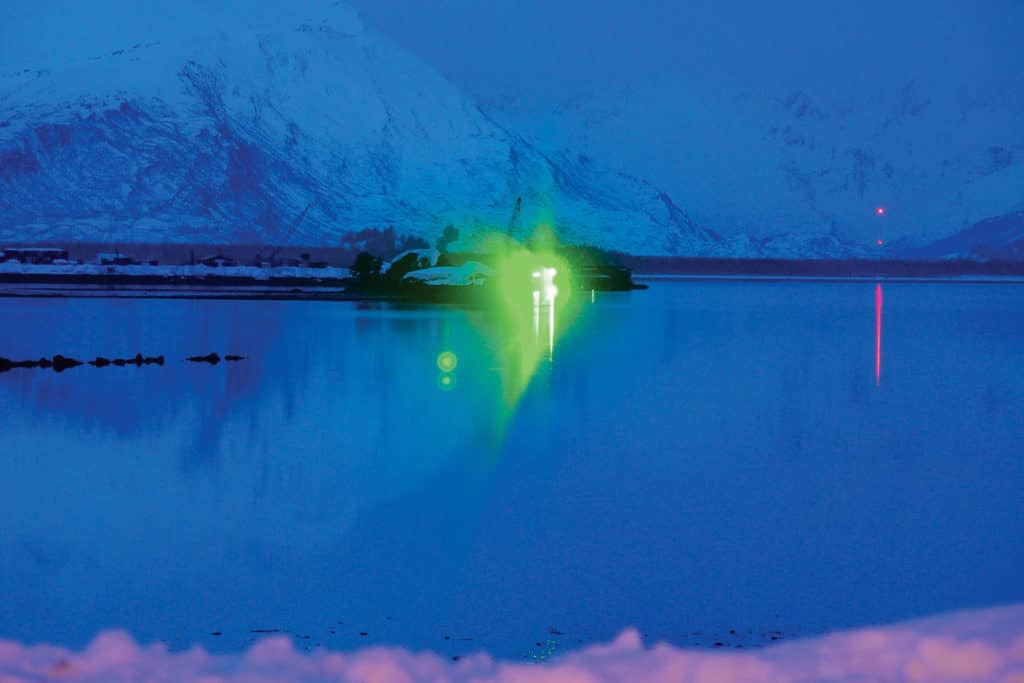
Green Rescue Laser Flare Test
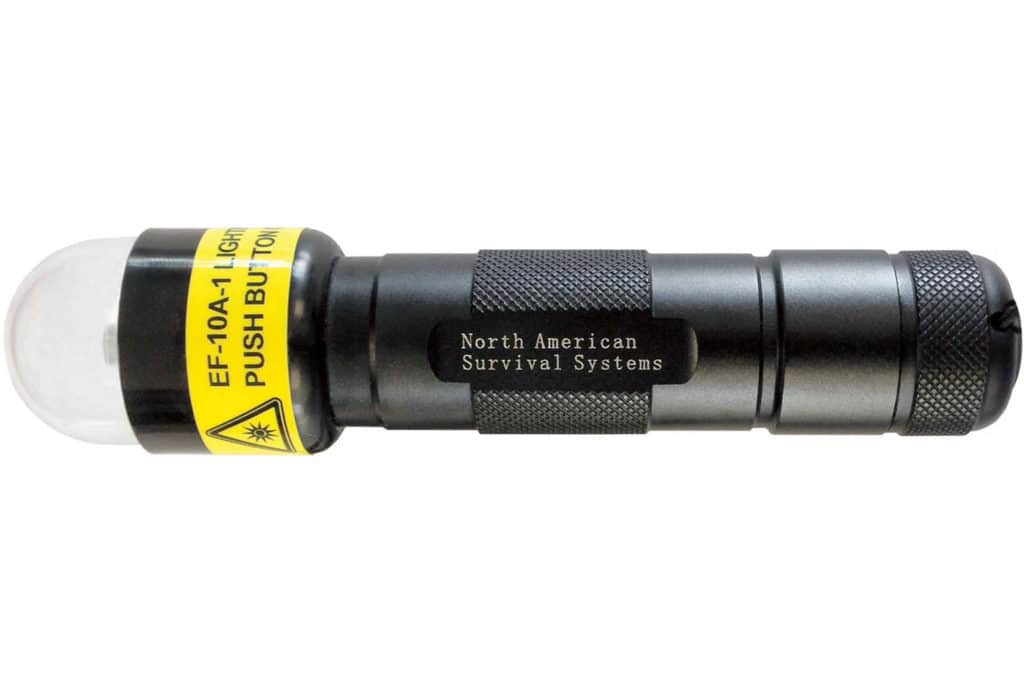
EF-10A-1 Lightning Flare
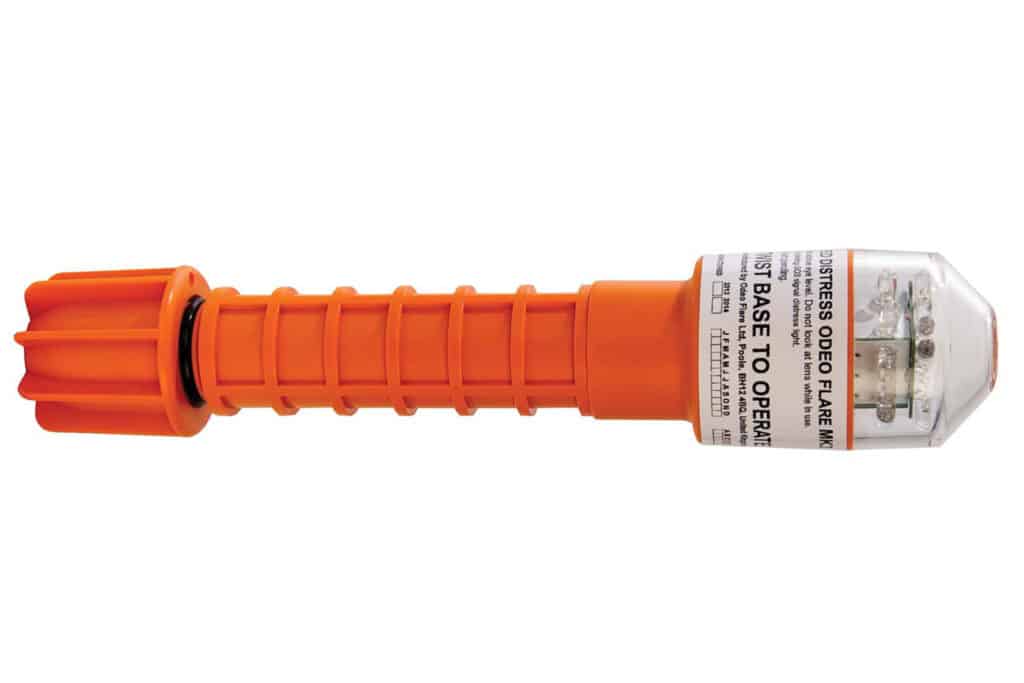
ODEO M3 Electronic Flare
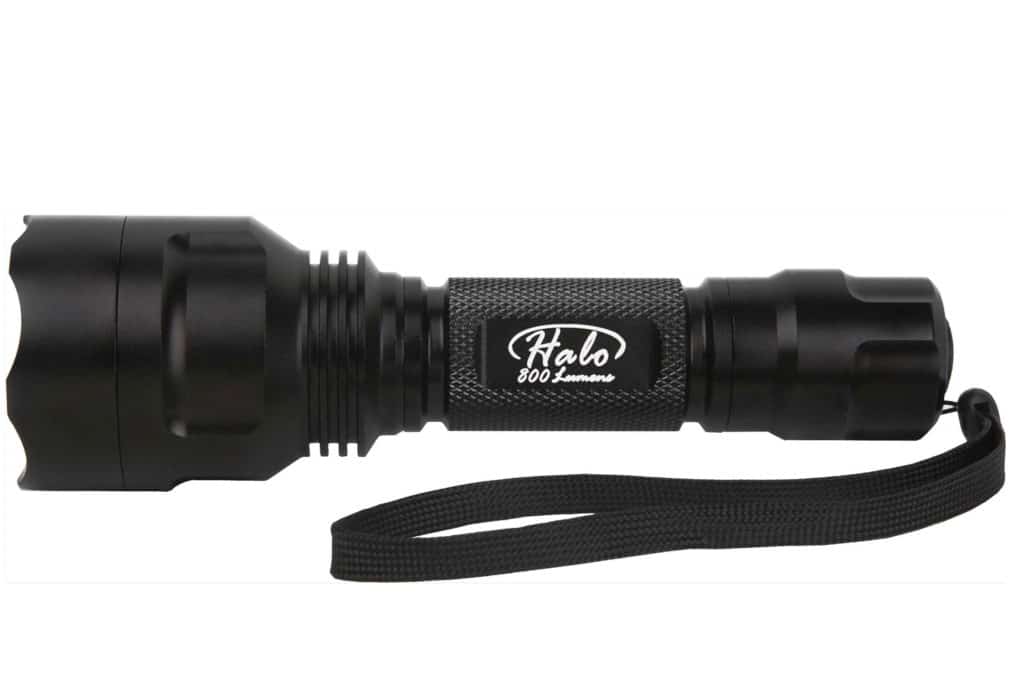
Halo Torch
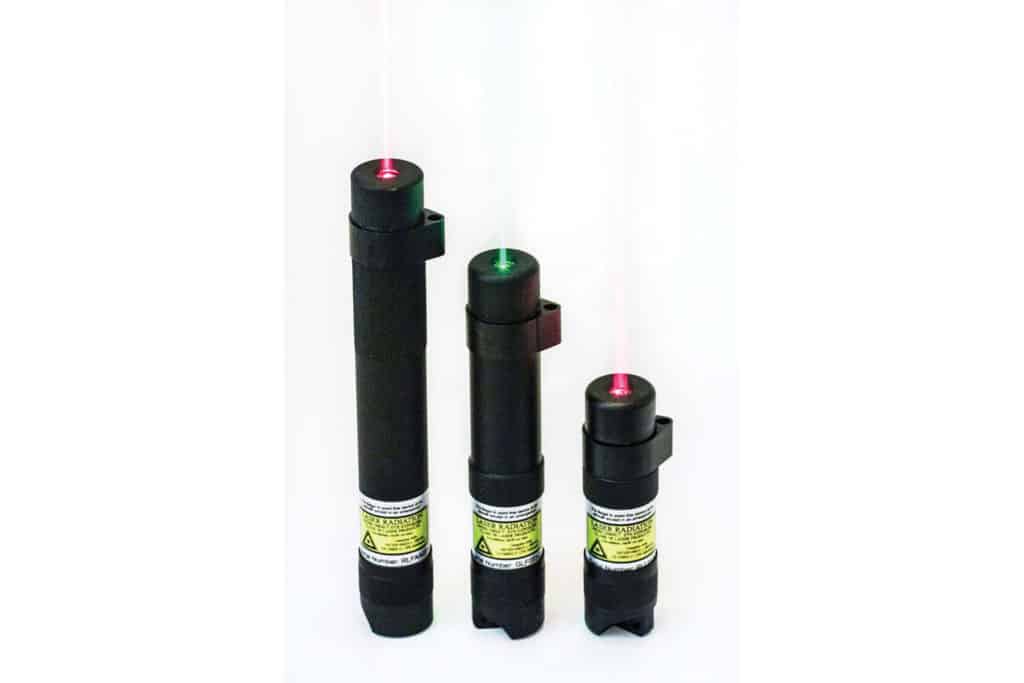
Rescue Laser Flare Magnum
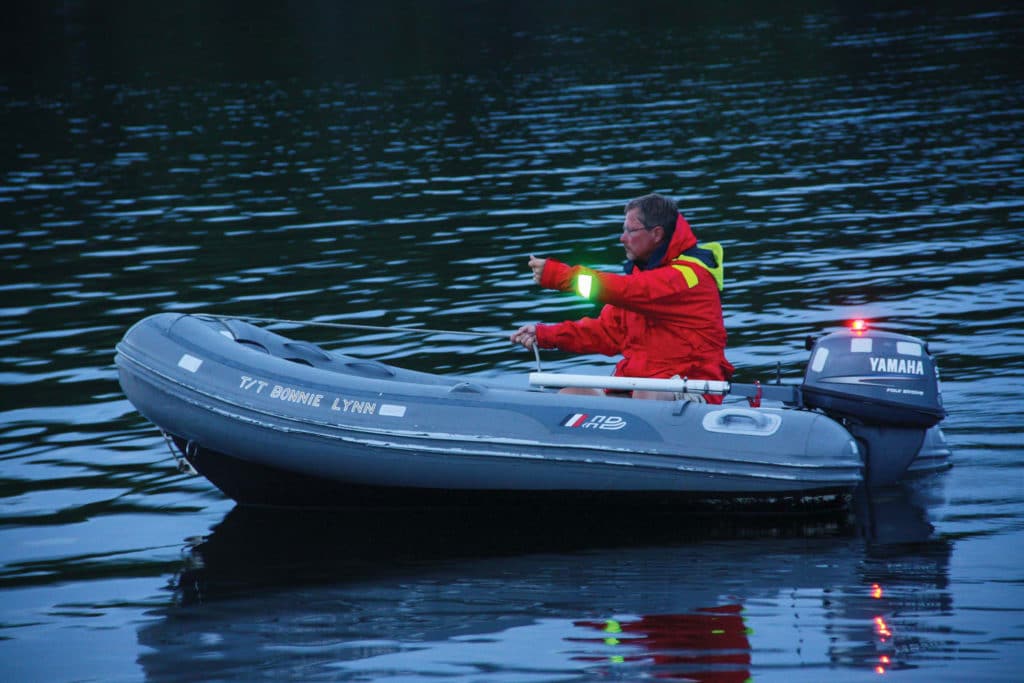
Green Laser Use
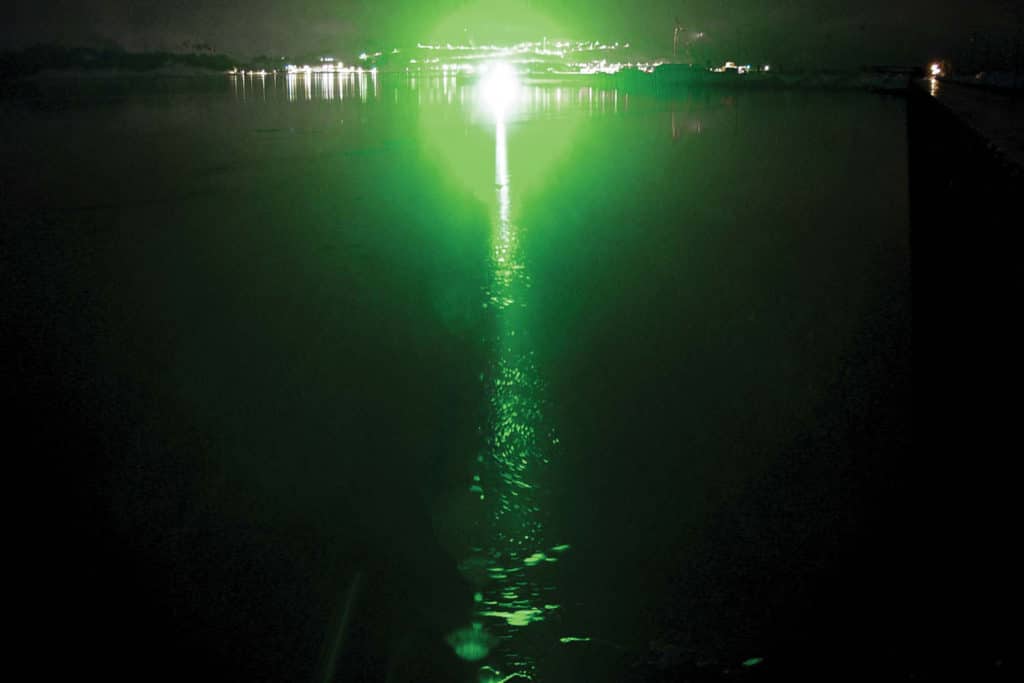
Green Rescue Laser Flare
